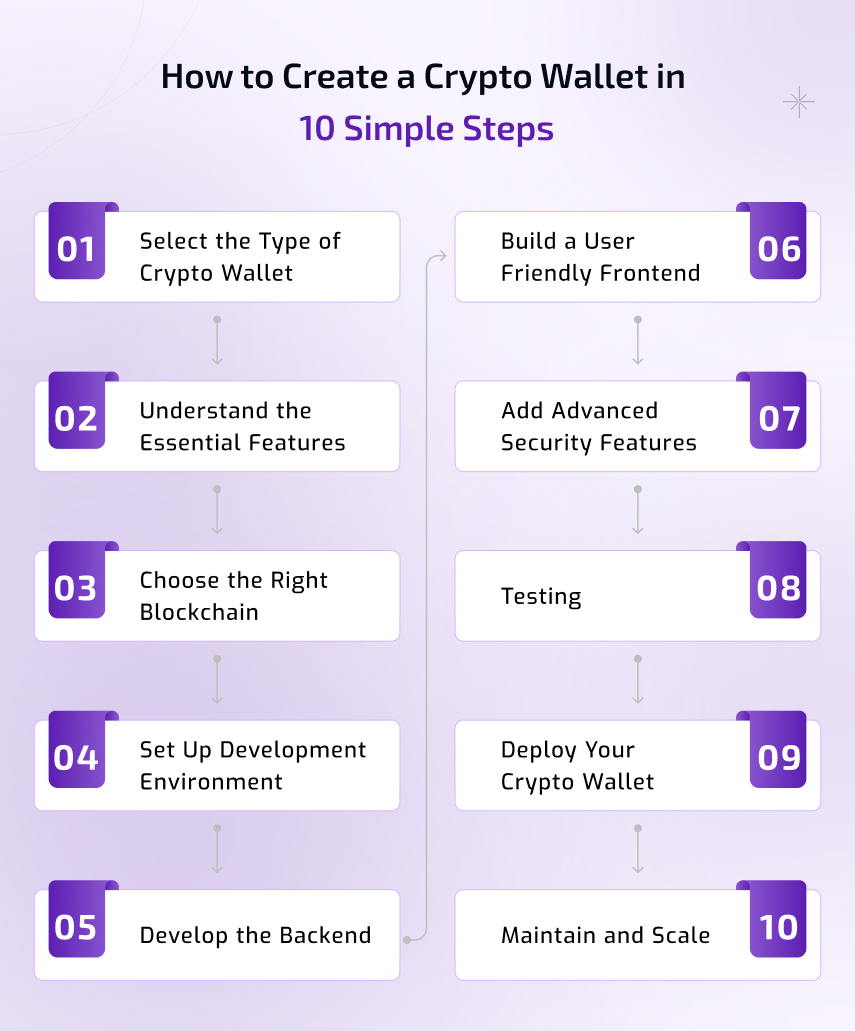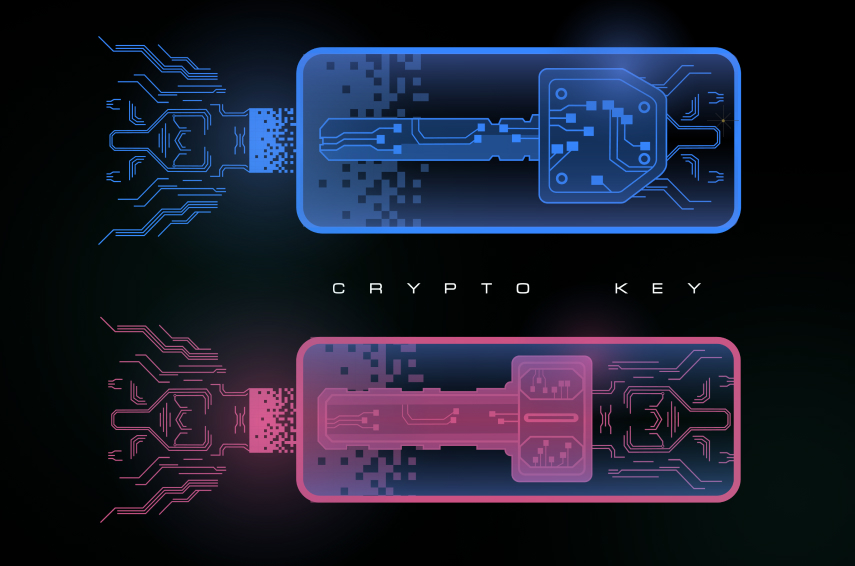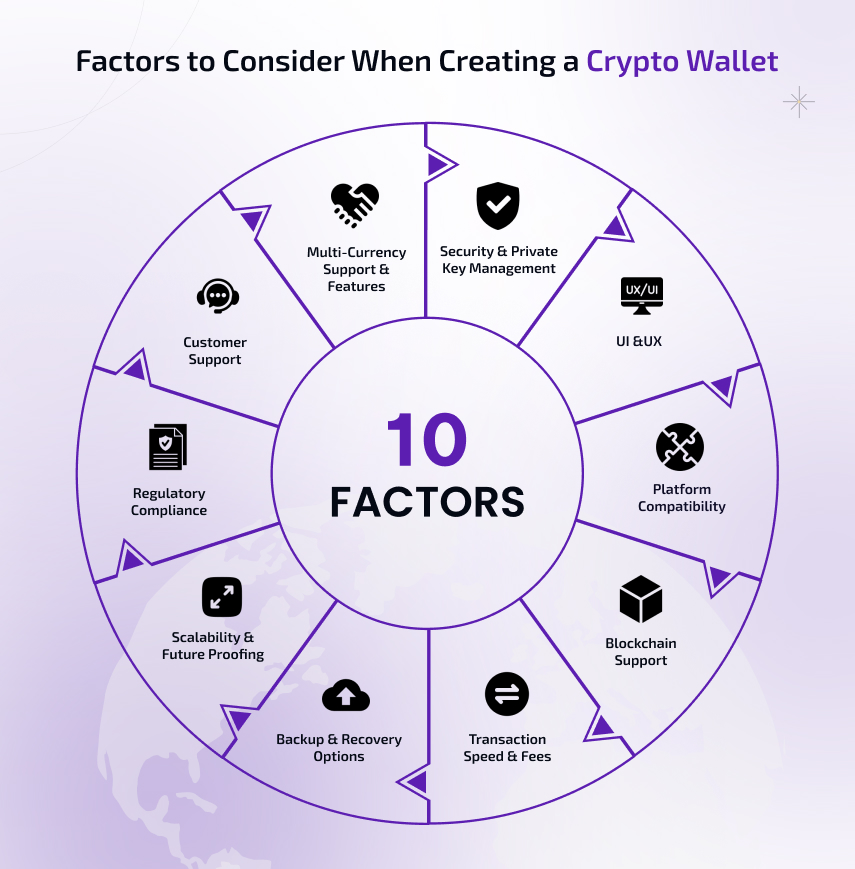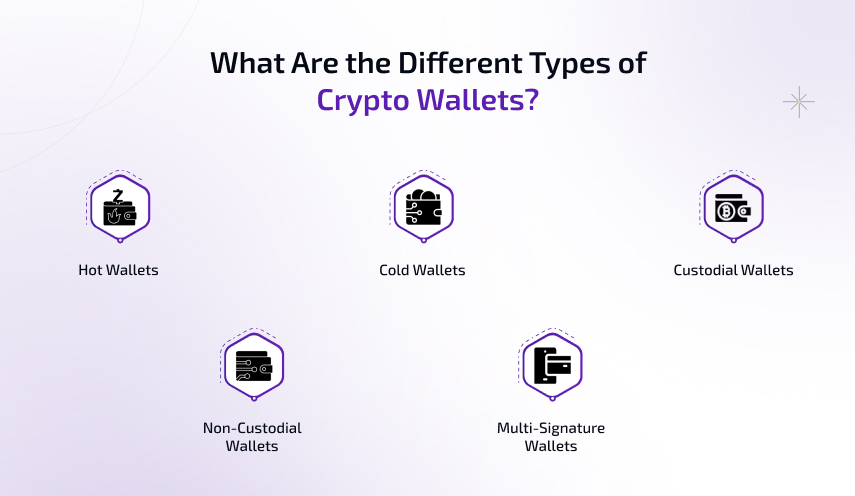How to Create a Crypto Wallet in 10 Simple Steps
10 Dec 2024Listen to the Audio :
The rising need for the cryptocurrencies necessitates the immediate cryptocurrency wallet deployment of a safe used in managing digital assets. In fact, a cryptocurrency wallet is a basic tool for ensuring safety in holding, managing and executing transactions concerning digital assets.For both developers aiming to provide solutions for their organizations and individuals concerned about the security of their finances, understanding how to create a crypto wallet is absolutely vital.
This article helps you understand how to create a crypto wallet with the general procedures and best practices that are sure to bring about success. You’ll learn how to create a crypto wallet app with secure features and seamless functionality for managing digital assets. This guide also includes insights to create your own cryptocurrency wallet that supports diverse blockchain ecosystems effectively.Additionally, we’ll explore how to create a crypto wallet tailored to meet modern security and usability standards.
What is a Cryptocurrency Wallet?
Cryptocurrency wallet is a digital wallet or storage, which enables the user to safely store, administer, and trade their currencies. It doesn't store any physical currency; however, it stores the complete set of private and public keys through which a person can get access to the assets and make the corresponding actions on their blockchain account.
There are different kinds of wallets: hardware wallets, software wallets, and web wallets, with varying levels of security and convenience. For knowing how to create a crypto wallet, it is necessary to first understand the core functionalities of a crypto wallet such as encryption, private key storage, and transaction capabilities.Developers must choose the appropriate blockchain platform and tools to build a crypto wallet or develop a crypto wallet. You can even create own cryptocurrency wallet app to provide better security while allowing smooth access to funds across several devices.
How to Create a Crypto Wallet in 10 Simple Steps

Creating a crypto wallet is the most complicated process that appears in simple steps. If you want to know how to create a crypto wallet, read this step-by-step guide for more information.
Step 1: Select the Type of Crypto Wallet
First you have to choose the kind of wallet you want to have before learning how to create a crypto wallet. Two substantially different types of wallets are a hot and a cold wallet. The hot wallets stay constantly online, so it's ideal for frequent transactions. These include mobile, desktop, and web wallets. They are mostly liked by those who planing for cryptocurrency wallet development because they are highly accessible and popular.
But then, there are the cold wallets: for instance, hardware wallets and paper wallets. These wallets never connect to the internet. Therefore, they provide maximum security in terms of storing crypto for long. This depends on whether convenience or security you prefer.
Step 2: Understand the Essential Features
Among other basic qualities, a crypto wallet offers security, functionality, and user delight. Usually, the basic key management for any wallet is seen as the vital capacity in this sense. It will therefore cover both in secure and encrypted sensitive keys as well as in their production management. The security provided by these wallets shuts user access without suitable permission by means of PINs, biometrics, or two-factor authentication.
A crypto wallet also needs to fit various currencies. One wallet therefore lets a user retain and manage many coins. The other features that should not miss in your wallet include an in-depth transaction history for purposes of tracking and a very user-friendly interface to ensure smooth navigation. Whether it's how to create a crypto wallet app or a web-based wallet, these are the basics for a successful product.
Step 3: Choose the Right Blockchain
An important decision when learning how to create a crypto wallet is which blockchain your wallet will run on. Every blockchain is built for different applications. Bitcoin is ideal for wallets that are only for Bitcoin transactions. Ethereum, often associated with ERC20 token development, is flexible enough to handle ETH, ERC-20 tokens, and NFTs. Binance Smart Chain, popular for BEP20 token development, is ideal for fast and low-cost transactions.
Solana uses high-speed performance with low fees. The blockchain that you will select determines which tools and technologies you would be working with when you develop, so pick a blockchain that is appropriate for the purpose your wallet will have to serve.
Step 4: Set Up the Development Environment
The proper developing environment is necessary to establish the crypto wallet.You should select the appropriate programming language that your blockchain is going to support-Rust, Python, and JavaScript.Libraries like Web3.js or ethers.js are very useful for Ethereum wallets, and Bitcoin wallets rely on BitcoinJS. Services like Infura, Alchemy, and QuickNode make it very easy to connect to blockchain networks, which makes the development process much easier. So, to understand how to create a crypto wallet, one must understand these tools and how to integrate them correctly.
Step 5: Develop the Backend
The backend is especially crucial for handling private keys, establishing addresses, and dealing with blockchain. A fine backend will have methods of securing unique addresses to be produced and APIs through which a blockchain transaction runs smoothly.They allow sending, receiving, or verifying transactions and keep everyone updated in real time due to blockchain explorers.
Security is a must-one needs to encrypt user data with the latest techniques in order to avoid illegal access. A strong backend has been established to understand how to create a crypto wallet that would be carried out smoothly.
Step 6: Build a User-Friendly Frontend
A frontend would be that part of your crypto wallet that is visible to your users, or they interact with. Good interface makes it a key when finding out how to create your crypto wallet app. Aspects like this are significant for the user experience, thus determining if the wallet in question is user-friendly or otherwise. HTML5, CSS, and JavaScript are usually preferred when it comes to web-based wallets. Develop it using modern tools such as React Native or Flutter.
The sophisticated and user-friendly UI/UX designs should have features such as scanning a QR code without a hitch and with real-time transaction updates. That would give real-time feedback of each transaction and inform users about network delay, hence decreasing uncertainty and increasing the amount of trust in the user interface.You will learn how to create a crypto wallet app with anintuitive user interface.
Step 7: Add Advanced Security Features
No cryptocurrency wallet is complete without robust security measures. If you want to create a crypto wallet app, prioritize advanced security features to safeguard users' funds and data.Most of them, including 2FA, rely on SMS codes or an authenticator app and more fundamentally, on a hardware token. Multi-signature transactions make things safer because several parties must agree to take some critical action before taking it.
Some ways of backing up and recovery are also possible. There is recovery by a wallet recovery seed phrase or encrypted file if your wallet gets lost. Your wallet will never win the trust of users no matter how many other functionality it contains if proper security measures are not developed.
Step 8: Testing
Once the back-end and front-end are developed and integrated, it should be tested in detail. This includes defects, security flaws, and performance bugs. All functions must be tested in detail; this includes transaction processes, user authentication, and the backup system to ensure that everything works without a hitch.
Tests on numerous devices and operating systems ensure that it is compatible and reliable. The development of a secure, efficient, and publicly deployable cryptocurrency wallet has to be thoroughly tested. Testing forms the best part of learning on how to create a crypto wallet app that is secure.
Step 9: Deploy Your Crypto Wallet
After the testing phase, it should be opened to public, mobile wallets should be downloadable over Google Play Store and Apple App Store. Web wallets over SSL encrypted secure server should be hosted, updating should be provided in fixing problems or added features periodically.
Step 10: Maintain and Scale
Generally, the maintenance ensures it remains usable and secure about your cryptocurrency wallet. Periodic updates ought to eliminate errors, speed up, and provide the users with the enhancements they need. With a growing user base, it is essential to enhance the wallet by adding other cryptocurrencies and staking or DeFi tools. With time, the wallet remains trustworthy and competitive because updates will come with scalability and security priority by frequent audits of faults and improvement of protection.
This will open enormous opportunities in the crypto market once you know how to create a crypto wallet. The above given steps help you build a crypto wallet that is secure and scalable. Whether you're planning to create your own cryptocurrency wallet app or a web wallet, focusing on essential features, security, and user experience ensures success. Start your journey today and develop a crypto wallet that stands out in the competitive market!
What is a Private Key and Public Key?

When learning how to create a crypto wallet, it’s essential to understand the fundamental concepts of private keys and public keys.
Public Key
A public key is an account number that you can share with someone. It is a cryptographic address that you can share with somebody. Anyone can send a cryptocurrency to your wallet by using your public key. Nobody can withdraw it to his account. The public key is safe to be shared because others can send money to your wallet only, but cannot access it.
A public key is derived through a mathematical process called public-key cryptography from your private key. Once you create your own cryptocurrency wallet, your wallet software automatically generates a public key during the process of creating the wallet. It is a key that others will use in making transactions with you.
Private Key
A private key is a secret cryptographic key that can allow access and control over funds in a wallet. It is used for signing transactions, which would then prove the authorization of a transaction by the rightful owner of the wallet. The private key has to be kept secure and confidential since any person having access to it can spend funds from your wallet.The private key is critical in how to create a crypto wallet app. Without it, the user will not be able to sign a transaction and, therefore, cannot authorize it.
When you want to create your own cryptocurrency wallet, understanding private keys and public keys is essential for ensuring secure transactions. The generation of these two keys is part of how to create a crypto wallet and automatically happens in the process of wallet setup procedure. You don't have to do this yourself; this will be done by wallet software itself.
How Private and Public Keys Work Together
In most crypto wallets, the public and private key work together to keep transactions safe:
Receive money:
You share your public key, so people can pay you by sending funds to the respective address; since it's an open public key, then everyone will know where exactly to send funds to you.
Sending Funds:
While sending funds, you use your private key in signing the transaction. Therefore, you can be assured that you are in possession of the funds you seek to send and that verifies the transaction itself.
This will ensure that any person may send money to your wallet by using your public key but no one but you may authorize a transaction from the wallet through your private key.If you are learning how to create a crypto wallet app or even looking to develop crypto wallet software, incorporating proper private key and public key management is crucial for the app’s functionality.
Public and Private Key Integration
When you create own cryptocurrency wallet, you’re essentially building the infrastructure to handle private key generation, storage, and security. Whether you're learning how to create a crypto wallet app or you’re designing the backend of a crypto wallet, both the private key and public key are necessary components that need to be handled securely.
If you’re developing a crypto wallet application, integrating these key pairs properly is essential for the app’s performance and security. The wallet software must ensure that the private key is kept secure, possibly in an encrypted storage solution, while allowing the public key to be accessed freely for transactions.
Understanding private keys and public keys is fundamental when you’re learning how to create a crypto wallet. If you’re looking to create own cryptocurrency wallet, build a crypto wallet, or develop crypto wallet apps, implementing proper key management and encryption is crucial for ensuring security.
Factors to Consider When Creating a Crypto Wallet

When considering how to create a crypto wallet, consider security, usability, and features that enhance functionality. Here is a detailed overview of factors to keep in mind when you build a crypto wallet or consider how to create a crypto wallet app:
Security and Private Key Management
The most important aspect of how to create a crypto wallet is security. Private keys have to be encrypted and must be kept in safe places. Add multi-signature transactions, as well as 2FA, to make it more secure. As you are developing a crypto wallet, make sure you have proper backup options like recovery phrases that can help a user regain access if lost.
User Interface (UI) and Experience (UX)
When you create a crypto wallet app, usability matters. A clean and intuitive design makes wallet management easier. Make sure it's easy to navigate, have clear transaction history, and include all the essential features for sending and receiving crypto.
Platform Compatibility
Determine where you will use your wallet. Whether it is through mobile applications (iOS/Android), desktop, or internet-based platforms, the ability to create a crypto wallet depends on the best application for your target audience's needs.
Blockchain Support
For a wallet to be useful, it must support the cryptocurrencies users want to store. When you create own cryptocurrency wallet, ensure compatibility with major blockchains like Bitcoin and Ethereum, or consider adding support for multiple blockchains depending on your wallet’s goals.
Transaction Speed and Fees
A crucial consideration for any wallet is backup and recovery. When creating your crypto wallet, offer it to the user as their recovery phrase to recover to in case of loss to a device. A fully trusted wallet must provide all these features.
Backup and Recovery Options
A crucial consideration for any wallet is backup and recovery. When developing a crypto wallet, provide users with a recovery phrase for restoring access in case of device loss. This backup functionality is essential for a trusted wallet.
Scalability and Future Proofing
Cryptocurrency technologies change fast. Make sure your wallet is scalable to accommodate new coins, tokens, and blockchain protocols. Build a crypto wallet with future enhancements in mind will keep your app relevant.
Regulatory Compliance
Depending on where you are, you may need to comply with KYC (Know Your Customer) and AML (Anti-Money Laundering) regulations. Make sure your wallet meets these standards when you create a crypto wallet to avoid legal issues.
Customer Support
Effective customer support is the key to solving user problems. Whether it is through help desks or FAQs, ensure that users have access to helpful resources when they face problems. A responsive support system can significantly improve your wallet's reputation.
Multi-Currency Support and Features
It's flexible because it can handle multiple cryptocurrencies. When you create own cryptocurrency wallet, ensure that the wallet will handle several tokens. Such inbuilt features as staking, scanning of the QR code, and the integration of dApps improves the functionality of the wallet.
Support for multiple cryptocurrencies adds flexibility. When you create own cryptocurrency wallet, make sure it handles a variety of tokens. Features like staking, QR code scanning, and dApp integration can enhance the wallet’s functionality.
By focusing on these critical factors when developing a crypto wallet, you can ensure that the wallet is secure, user-friendly, and scalable. Whether you’re learning how to create a crypto wallet app or aiming to build crypto wallet solutions for your users, keeping these elements in mind will lead to a successful and trusted product.
What Are the Different Types of Crypto Wallets?

When learning how to create a crypto wallet, it’s important to understand the different types of wallets available to users. Each type offers different levels of security, convenience, and compatibility with various cryptocurrencies:
1. Hot Wallets
Hot wallets are internet-enabled and thus facilitate easy access to funds instantly, which makes them more ideal for frequent transactions. When you build a crypto wallet, hot wallets include mobile apps, web wallets, and desktop wallets. While they offer ease of use, they are more vulnerable to hacking.
2. Cold Wallets
Cold wallets are those offline storage solutions such as hardware wallets and paper wallets. It is more secure because the private keys stay offline. When you create own cryptocurrency wallet, cold wallets are more suited for long-term storage and are less prone to online attacks.
3. Custodial Wallets
Third-party wallets include custodial wallets, in which a service provider is responsible for users' private keys. This type of wallet is convenient, but users must be willing to trust the service provider with their assets. As you develop a crypto wallet, consider whether you want to offer custodial services or non-custodial wallets where users retain control over their private keys.
4. Non-Custodial Wallets
Non-custodial wallets give full control of the private keys to the user. It is more secure as a third party cannot access and control the user's assets. If you are studying on how to create a crypto wallet app, the user will be given an opportunity for decentralization if a non-custodial wallet is adopted.
5. Multi-Signature Wallets
Multi-signature wallets require multiple private keys to approve a transaction, adding a layer of security. When you build a crypto wallet, these wallets are ideal for businesses or organizations where several parties need to approve transactions.
Common Mistakes to Avoid When Creating a Crypto Wallet
Most developers when they know how to create a crypto wallet end up falling into common pitfalls that might result in a security issue, poor user experience, or even lack scalability. Here are some common mistakes to avoid:
Inadequate Security Measures
Security should be a top priority when learning how to create a crypto wallet. Lack of proper encryption of private keys, unsecured authentication mechanisms, and poor-quality backup mechanisms expose users to numerous threats. Be sure to utilize multi-layered security features such as 2FA and ensure strong encryption is used to store the private key.
Ignoring User Experience (UX)
It's very simple to build a crypto wallet, but still sometimes the functionality may distract people so much that the user experience and the design suffer from it. Bad UI can make a poorly-designed wallet with awful navigation quite hateable to be used by users. The usability should be intuitive; clear, with neat navigation and nothing complicated in design or user experience.
Overcomplicating Features
Tendency of having too many feature aspects at first when developing a crypto wallet application; it might be the prime reason that the wallet is very complex. At first, begin with the very simple features, for example, sending and receiving coins, viewing history transactions, and safe management of keys to your funds. Later, complex features come into view only when someone acquires an adequate feeling for basic features.
Lack of Multi-Currency Support
If you’re trying to create own cryptocurrency wallet, neglecting multi-currency support is a mistake. Cryptocurrencies are diverse, and users will expect a wallet that can store and manage multiple types of coins and tokens. At the very least, support Bitcoin and Ethereum, with the option to add more in the future.
Failure to Regularly Update and Maintain
After you develop a crypto wallet, it is important to keep updating and upgrading it by filling up those vulnerabilities with new functionality and improve the performance. Otherwise, you risk becoming a victim of security exploits.
By avoiding these common mistakes, you can ensure that your crypto wallet is secure, user-friendly, and scalable, providing a better experience for your users.
Legal Considerations in Crypto Wallet Development

When learning how to create a crypto wallet, one must be aware of the legal considerations that may impact the development process. Cryptocurrency wallets generally operate in complex legal environments, and hence relevant regulations must be followed:
1. Know Your Customer (KYC) and Anti-Money Laundering (AML)
Many places require including KYC and AML policies. If you want to create own cryptocurrency wallet, you would like the application to be in line with the laws in your country by ensuring that who you are. Not having such processes will put you into a situation with the law or render you unable to provide your wallet in many areas.
2. Data Protection and Privacy Laws
The wallet must respect data privacy regulations as applicable in the GDPR in the EU or CCPA in California. The private keys and transaction records of users are classified to be sensitive information and must, therefore, be stored and processed using secured methods following such regulations.
3. Intellectual Property
Protection of rights associated with intellectual property is equally crucial for the crypto wallet development. If interested to develop crypto wallet solutions then, be cautious with the patent laws and ensure that it doesn't result in patents and trademarks infringement.
4. Licensing and Registration
Some countries require wallets to get licenses or registrations before they can offer their services to the public. Find out if your wallet needs to register with financial authorities, especially if it provides services such as exchange services or custodial wallets.
5. Taxation Compliance
There might be regulations on tax law in certain jurisdictions depending on how they view these wallets. Any wallet that has some sort of profit or staking functionality is likely to file transactions with tax authorities, so developers should ensure that the wallets they build have enough infrastructure to comply with the local tax laws.
Why Invest in Cryptocurrency Wallet Development?
With increasing global usage of cryptocurrencies, the creation of cryptocurrency wallets has slowly emerged as a necessity. The best reasons to build a crypto wallet are as follows:
Growing Demand for Crypto Solutions
With the mainstream acceptance of cryptocurrencies, the desire for safe and secure wallets keeps growing. Relatively speaking, a crypto wallet is a good investment because it caters to an increasingly growing demographic of users. When you create a crypto wallet app, it allows you to tap into one industry that presents vast opportunities for growth.
Security and Control over Assets
More reliable crypto wallet solutions help users to store, manage, and transfer their digital currencies safely and with control over the process, and thus they are more likely to be trusted. Develop your cryptocurrency wallet such that your users may manage their holdings.
Revenue Opportunities
Creae a crypto wallet that will enable you to generate multiple revenue streams through transactions, in-app purchases, or premium features. That way, it will be easier to monetize your wallet application and create a sustainable business model with the possibility of offering users smooth experiences that include added functionalities.
Decentralized Finance (DeFi) Integration
Most crypto wallets are integrated with DeFi protocols. Investing in how to create a crypto wallet opens users to DeFi services, such as staking, yield farming, and liquidity provision that will attract users who want to earn passive income.
Long-Term Viability
Since cryptocurrencies are here to stay and wallets will always be vital in the ecosystem as the technology supporting digital assets develops. Build a crypto wallet that makes it possible to create something that lasts and grows in scalability and could outlive the current trends of crypto space.
Investing in how to create a crypto wallet will put developers at the forefront of this cryptocurrency revolution since they will equip users with the crucial tools to correctly manage their digital assets.
Why Choose BlockchainX for Cryptocurrency Wallet Development?
BlockchainX is your trusted partner for creating secure and feature-rich cryptocurrency wallets. If you're looking to understand how to create a crypto wallet, we simplify the process with expert solutions designed for scalability and usability. Whether your goal is to create your own cryptocurrency wallet, build a crypto wallet from scratch, or develop a crypto wallet app, we deliver tailored solutions to meet your needs.
Our experienced team integrates advanced encryption, multi-currency support, and intuitive user interfaces to ensure a seamless experience for your users. We take the complexity out of how to create a crypto wallet app, guiding you through every step with cutting-edge tools and frameworks.
With BlockchainX, you can confidently develop crypto wallets that combine security, functionality, and innovation, giving your project a competitive edge in the growing cryptocurrency market.